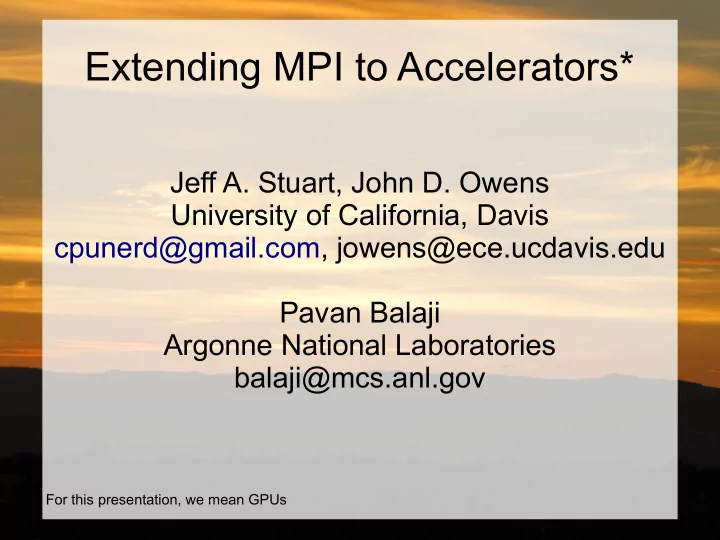

Extending MPI to Accelerators* Jeff A. Stuart, John D. Owens University of California, Davis cpunerd@gmail.com, jowens@ece.ucdavis.edu Pavan Balaji Argonne National Laboratories balaji@mcs.anl.gov * For this presentation, we mean GPUs
Outline ● Motivation ● Previous Work ● Proposal ● Challenges
Motivation ● HPC no longer (just) CPU ● GPUs Have Problems ● Slave Device ● No system calls
Previous Work ● Three Main Works ● cudaMPI ● GAMPI ● DCGN
Previous Work ● cudaMPI ● Handles buffer movement ● No ranks for GPUs
Previous Work ● GAMPI ● GPUs have ranks* ● More communicators ● Handles buffer movement
Previous Work ● DCGN ● GPUs have ranks ● GPUs source/sink communication* ● Doesn't implement standard MPI
Proposal ● Several Ideas ● No Ranks for GPUs ● Multiple Ranks per GPU Context ● One Rank per GPU Context ● New MPI Function(s) to Spawn Kernels
Proposal ● No Ranks for GPUs ● The way things work right now ● No changes necessary to MPI
Proposal ● Multiple Ranks Per Accelerator Context ● Ranks exist for lifetime of application – # of ranks chosen at runtime by user ● Modifications to MPI – Bind GPU threads to rank/MPI functions take source rank – Host must listen for requests ● Extra threads on CPU (one for each GPU)
Proposal ● One Rank per Accelerator Context ● Ranks exist for lifetime of Application ● Mapping of Processes:Contexts? ● Can CPU Processes use MPI communication?
Proposal ● New MPI Function(s) to Spawn Kernels ● New communicators and ranks after every spawn – Cleaned up after all kernels finish ● Intercommunicator(s) available upon request
Challenges ● Threads vs Processes ● Extra Communicators? ● Collectives ● Source/Sink Communication
Looking Forward ● GPU-Direct is good ● GPU-Direct 2 is great ● We want GPU-Direct 3 to ● Let GPU source/sink ● Use GPU-Direct 2 to interface with NIC ● Administer MPI ranks without CPU interference
One Last Note ● Graduating with Ph.D. In June 2012 ● Resume at http://jeff.bleugris.com/resume.pdf
Recommend
More recommend